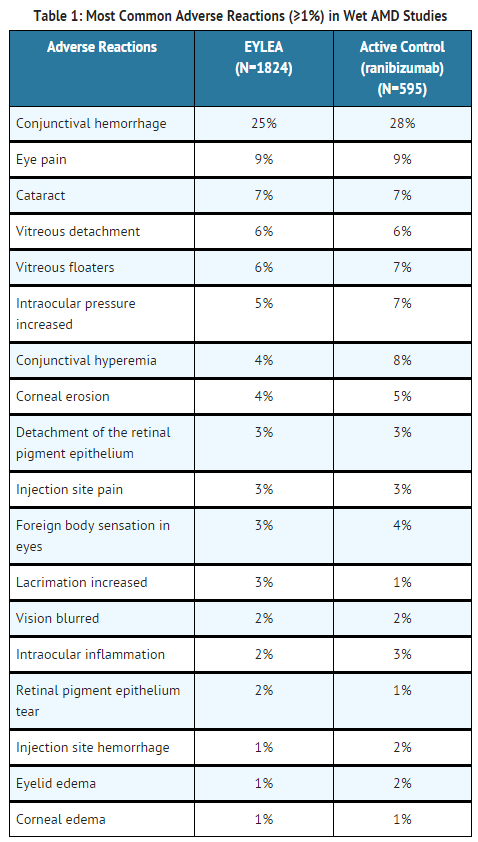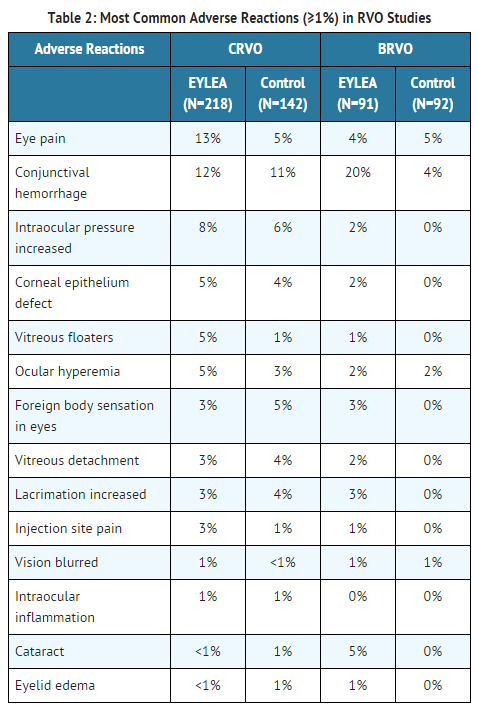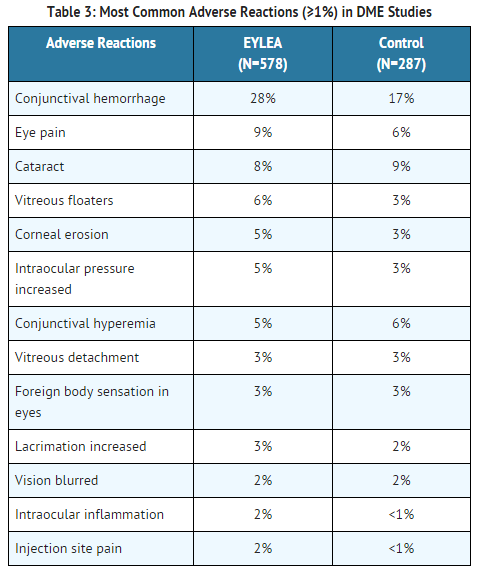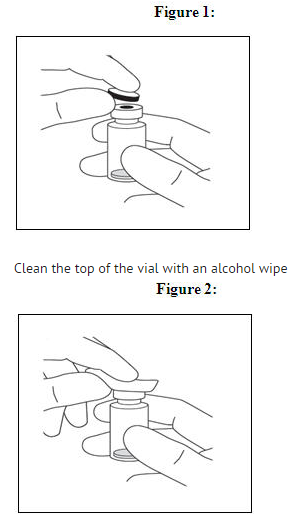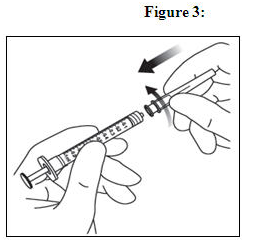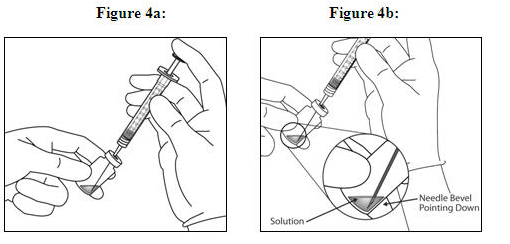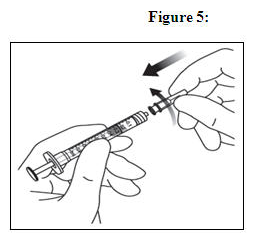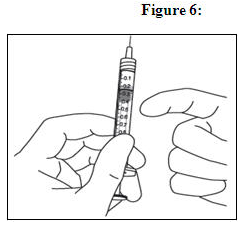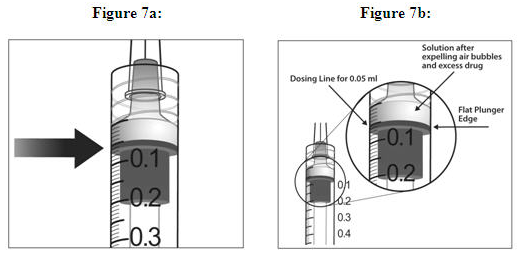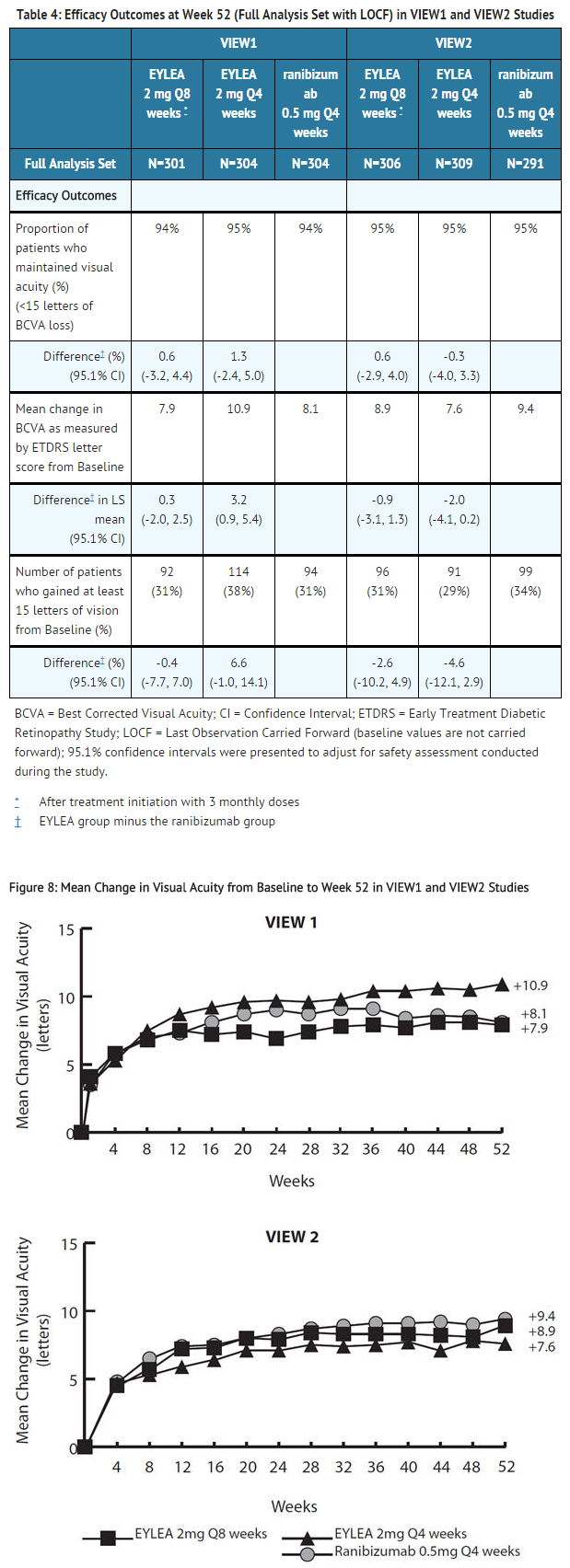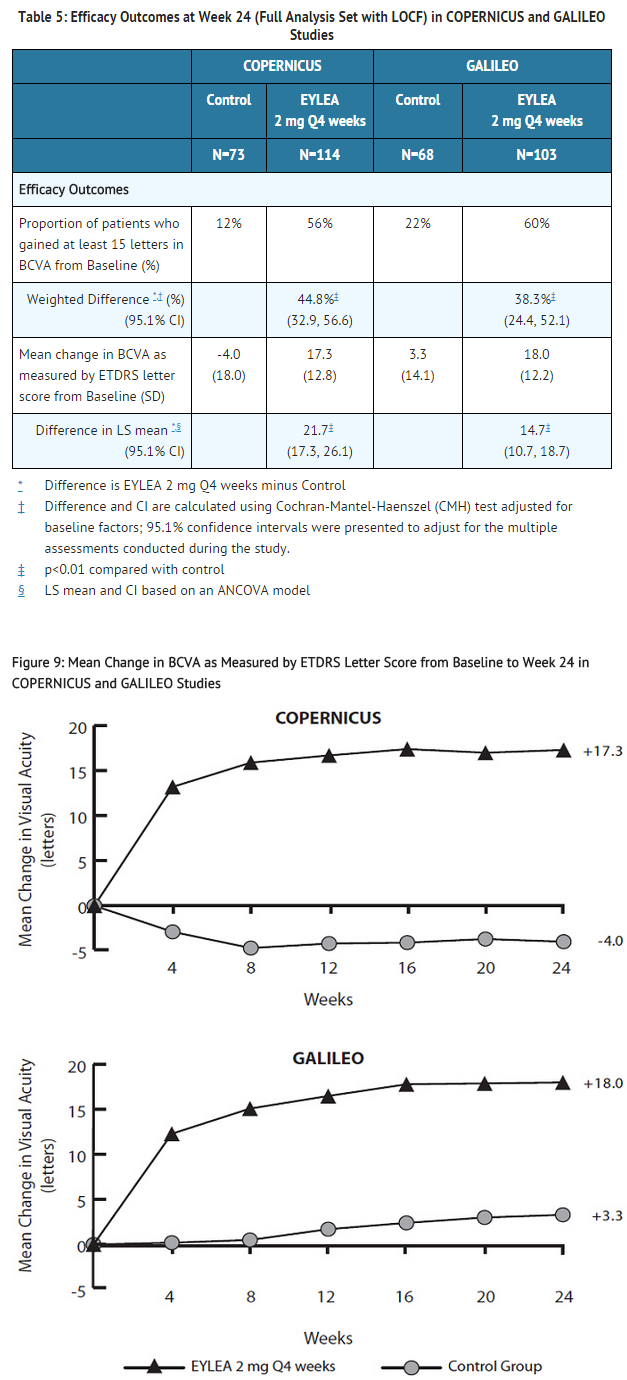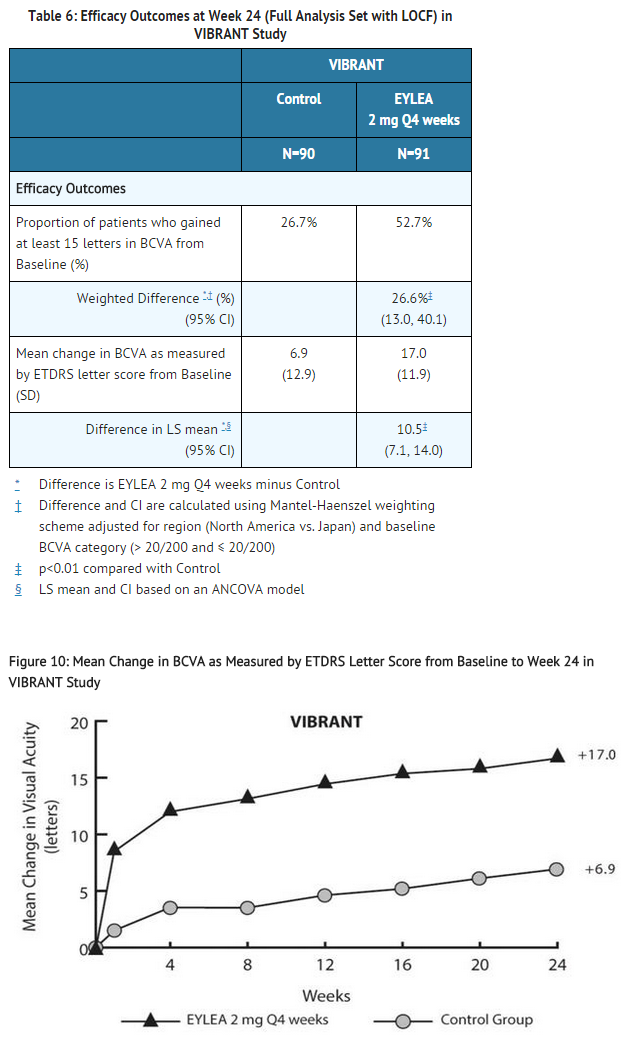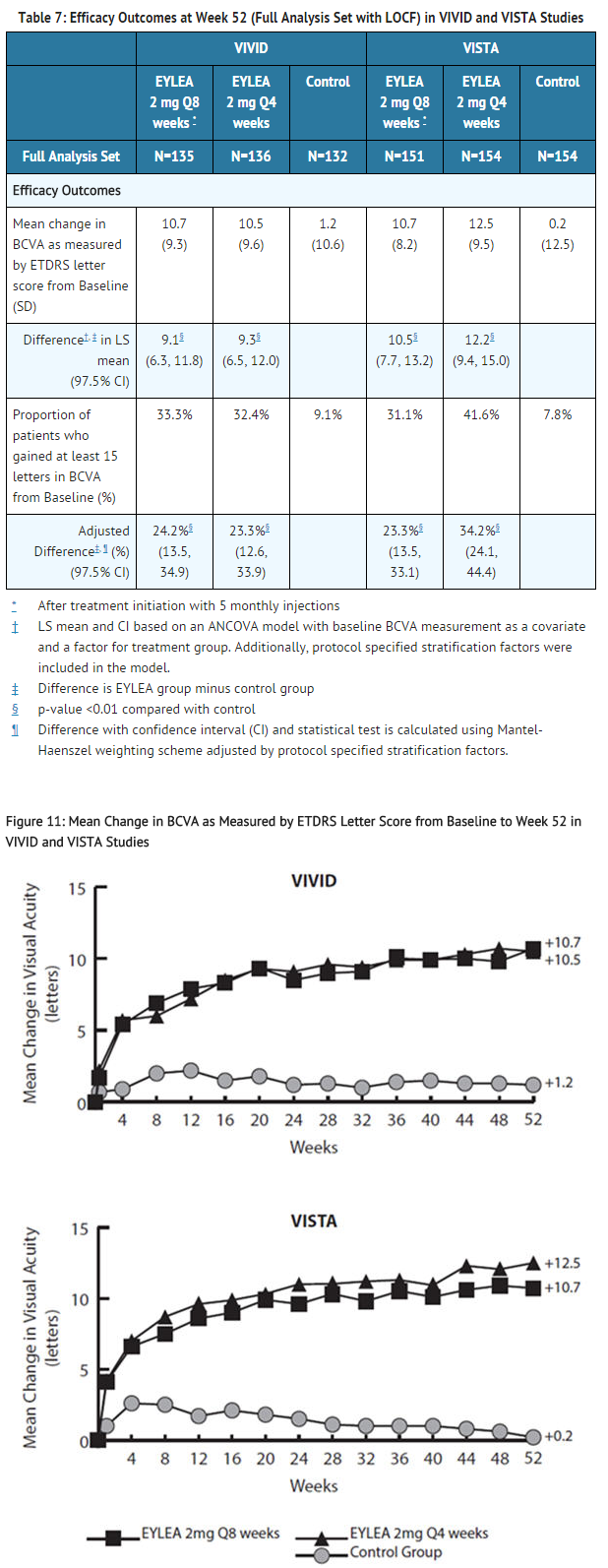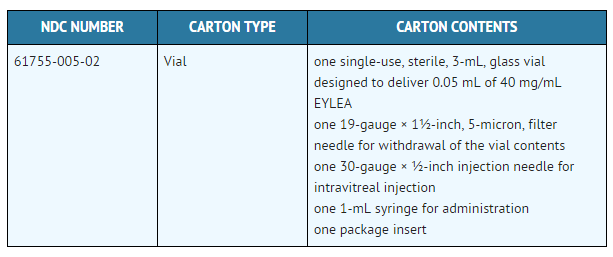Aflibercept: Difference between revisions
Rabin Bista (talk | contribs) No edit summary |
Rabin Bista (talk | contribs) No edit summary |
||
| Line 204: | Line 204: | ||
|fileName=No image.jpg | |fileName=No image.jpg | ||
}} | }} | ||
{{LabelImage}} | {{LabelImage | ||
|fileName=Aflibercept Ing and App.png | |||
}} | |||
{{LabelImage | {{LabelImage | ||
|fileName=Aflibercept PDP.png | |fileName=Aflibercept PDP.png | ||
Revision as of 21:24, 22 January 2015
Editor-In-Chief: C. Michael Gibson, M.S., M.D. [1];
Disclaimer
WikiDoc MAKES NO GUARANTEE OF VALIDITY. WikiDoc is not a professional health care provider, nor is it a suitable replacement for a licensed healthcare provider. WikiDoc is intended to be an educational tool, not a tool for any form of healthcare delivery. The educational content on WikiDoc drug pages is based upon the FDA package insert, National Library of Medicine content and practice guidelines / consensus statements. WikiDoc does not promote the administration of any medication or device that is not consistent with its labeling. Please read our full disclaimer here.
Overview
Aflibercept is a Ophthalmologic Agent that is FDA approved for the treatment of Macular Edema Following Retinal Vein Occlusion , Diabetic Macular Edema ,Neovascular (Wet) Age-Related Macular Degeneration. Common adverse reactions include conjunctival hemorrhage, eye pain, cataract, vitreous floaters, intraocular pressure increased, and vitreous detachment.
Adult Indications and Dosage
FDA-Labeled Indications and Dosage (Adult)
Indications
- Neovascular (Wet) Age-Related Macular Degeneration (AMD)
- Macular Edema Following Retinal Vein Occlusion (RVO)
- Diabetic Macular Edema (DME)
Dosage
Important Injection Instructions
- For ophthalmic intravitreal injection. EYLEA must only be administered by a qualified physician.
Neovascular (Wet) Age-Related Macular Degeneration (AMD)
- The recommended dose for EYLEA is 2 mg (0.05 mL or 50 microliters) administered by intravitreal injection every 4 weeks (monthly) for the first 12 weeks (3 months), followed by 2 mg (0.05 mL) via intravitreal injection once every 8 weeks (2 months). Although EYLEA may be dosed as frequently as 2 mg every 4 weeks (monthly), additional efficacy was not demonstrated when EYLEA was dosed every 4 weeks compared to every 8 weeks.
Macular Edema Following Retinal Vein Occlusion (RVO)
- The recommended dose for EYLEA is 2 mg (0.05 mL or 50 microliters) administered by intravitreal injection once every 4 weeks (monthly).
Diabetic Macular Edema (DME)
- The recommended dose for EYLEA is 2 mg (0.05 mL or 50 microliters) administered by intravitreal injection every 4 weeks (monthly) for the first 5 injections, followed by 2 mg (0.05 mL) via intravitreal injection once every 8 weeks (2 months). Although EYLEA may be dosed as frequently as 2 mg every 4 weeks (monthly), additional efficacy was not demonstrated when EYLEA was dosed every 4 weeks compared to every 8 weeks.
Dosage forms and Strengths
- Single-use, glass vial designed to provide 0.05 mL of 40 mg/mL solution (2 mg) for intravitreal injection.
Off-Label Use and Dosage (Adult)
Guideline-Supported Use
There is limited information regarding Off-Label Guideline-Supported Use of Aflibercept in adult patients.
Non–Guideline-Supported Use
There is limited information regarding Off-Label Non–Guideline-Supported Use of Aflibercept in adult patients.
Pediatric Indications and Dosage
FDA-Labeled Indications and Dosage (Pediatric)
There is limited information regarding FDA-Labeled Use of Aflibercept in pediatric patients.
Off-Label Use and Dosage (Pediatric)
Guideline-Supported Use
There is limited information regarding Off-Label Guideline-Supported Use of Aflibercept in pediatric patients.
Non–Guideline-Supported Use
There is limited information regarding Off-Label Non–Guideline-Supported Use of Aflibercept in pediatric patients.
Contraindications
Ocular or Periocular Infections
- EYLEA is contraindicated in patients with ocular or periocular infections.
Active Intraocular Inflammation
- EYLEA is contraindicated in patients with active intraocular inflammation.
Hypersensitivity
- EYLEA is contraindicated in patients with known hypersensitivity to aflibercept or any of the excipients in EYLEA. Hypersensitivity reactions may manifest as severe intraocular inflammation.
Warnings
Endophthalmitis and Retinal Detachments
- Intravitreal injections, including those with EYLEA, have been associated with endophthalmitis and retinal detachments [see ADVERSE REACTIONS (6.1)]. Proper aseptic injection technique must always be used when administering EYLEA. Patients should be instructed to report any symptoms suggestive of endophthalmitis or retinal detachment without delay and should be managed appropriately.
Increase in Intraocular Pressure
- Acute increases in intraocular pressure have been seen within 60 minutes of intravitreal injection, including with EYLEA [see ADVERSE REACTIONS (6.1)]. Sustained increases in intraocular pressure have also been reported after repeated intravitreal dosing with vascular endothelial growth factor (VEGF) inhibitors. Intraocular pressure and the perfusion of the optic nerve head should be monitored and managed appropriately.
Thromboembolic Events
- There is a potential risk of arterial thromboembolic events (ATEs) following intravitreal use of VEGF inhibitors, including EYLEA. ATEs are defined as nonfatal stroke, nonfatal myocardial infarction, or vascular death (including deaths of unknown cause). The incidence of reported thromboembolic events in wet AMD studies during the first year was 1.8% (32 out of 1824) in the combined group of patients treated with EYLEA. The incidence in the DME studies during the first year was 3.3% (19 out of 578) in the combined group of patients treated with EYLEA compared with 2.8% (8 out of 287) in the control group. There were no reported thromboembolic events in the patients treated with EYLEA in the first six months of the RVO studies.
Adverse Reactions
Clinical Trials Experience
Clinical Trials Experience
- Because clinical trials are conducted under widely varying conditions, adverse reaction rates observed in the clinical trials of a drug cannot be directly compared to rates in other clinical trials of the same or another drug and may not reflect the rates observed in practice.
- A total of 2711 patients treated with EYLEA constituted the safety population in seven phase 3 studies. Among those, 2110 patients were treated with the recommended dose of 2 mg. Serious adverse reactions related to the injection procedure have occurred in <0.1% of intravitreal injections with EYLEA including endophthalmitis and retinal detachment. The most common adverse reactions (≥5%) reported in patients receiving EYLEA were conjunctival hemorrhage, eye pain, cataract, vitreous floaters, intraocular pressure increased, and vitreous detachment.
Neovascular (Wet) Age-Related Macular Degeneration (AMD)
- The data described below reflect exposure to EYLEA in 1824 patients with wet AMD, including 1223 patients treated with the 2-mg dose, in 2 double-masked, active-controlled clinical studies (VIEW1 and VIEW2) for 12 months
- Less common serious adverse reactions reported in <1% of the patients treated with EYLEA were hypersensitivity, retinal detachment, retinal tear, and endophthalmitis.
Macular Edema Following Retinal Vein Occlusion (RVO)
- The data described below reflect 6 months exposure to EYLEA with a monthly 2 mg dose in 218 patients following CRVO in 2 clinical studies (COPERNICUS and GALILEO) and 91 patients following BRVO in one clinical study (VIBRANT).
- Less common adverse reactions reported in <1% of the patients treated with EYLEA in the CRVO studies were corneal edema, retinal tear, hypersensitivity, and endophthalmitis.
Diabetic Macular Edema (DME)
- The data described below reflect exposure to EYLEA in 578 patients with DME treated with the 2-mg dose in 2 double-masked, controlled clinical studies (VIVID and VISTA) for 52 weeks
- Less common adverse reactions reported in <1% of the patients treated with EYLEA were hypersensitivity, eyelid edema, corneal edema, retinal detachment, injection site hemorrhage, and retinal tear.
Immunogenicity
As with all therapeutic proteins, there is a potential for an immune response in patients treated with EYLEA. The immunogenicity of EYLEA was evaluated in serum samples. The immunogenicity data reflect the percentage of patients whose test results were considered positive for antibodies to EYLEA in immunoassays. The detection of an immune response is highly dependent on the sensitivity and specificity of the assays used, sample handling, timing of sample collection, concomitant medications, and underlying disease. For these reasons, comparison of the incidence of antibodies to EYLEA with the incidence of antibodies to other products may be misleading.
- In the wet AMD, RVO, and DME studies, the pre-treatment incidence of immunoreactivity to EYLEA was approximately 1% to 3% across treatment groups. After dosing with EYLEA for 24-52 weeks, antibodies to EYLEA were detected in a similar percentage range of patients. There were no differences in efficacy or safety between patients with or without immunoreactivity.
Postmarketing Experience
There is limited information regarding Postmarketing Experience of Aflibercept in the drug label.
Drug Interactions
There is limited information regarding Aflibercept Drug Interactions in the drug label.
Use in Specific Populations
Pregnancy
- Aflibercept produced embryo-fetal toxicity when administered every three days during organogenesis to pregnant rabbits at intravenous doses ≥3 mg per kg, or every six days at subcutaneous doses ≥0.1 mg per kg. Adverse embryo-fetal effects included increased incidences of postimplantation loss and fetal malformations, including anasarca, umbilical hernia, diaphragmatic hernia, gastroschisis, cleft palate, ectrodactyly, intestinal atresia, spina bifida, encephalomeningocele, heart and major vessel defects, and skeletal malformations (fused vertebrae, sternebrae, and ribs; supernumerary vertebral arches and ribs; and incomplete ossification). The maternal No Observed Adverse Effect Level (NOAEL) in these studies was 3 mg per kg. Aflibercept produced fetal malformations at all doses assessed in rabbits and the fetal NOAEL was less than 0.1 mg per kg. Administration of the lowest dose assessed in rabbits (0.1 mg per kg) resulted in systemic exposure (AUC) that was approximately 10 times the systemic exposure observed in humans after an intravitreal dose of 2 mg.
- There are no adequate and well-controlled studies in pregnant women. EYLEA should be used during pregnancy only if the potential benefit justifies the potential risk to the fetus.
Pregnancy Category (AUS):
There is no Australian Drug Evaluation Committee (ADEC) guidance on usage of Aflibercept in women who are pregnant.
Labor and Delivery
There is no FDA guidance on use of Aflibercept during labor and delivery.
Nursing Mothers
- It is unknown whether aflibercept is excreted in human milk. Because many drugs are excreted in human milk, a risk to the breastfed child cannot be excluded. EYLEA is not recommended during breastfeeding. A decision must be made whether to discontinue nursing or to discontinue treatment with EYLEA, taking into account the importance of the drug to the mother.
Pediatric Use
- The safety and effectiveness of EYLEA in pediatric patients have not been established.
Geriatic Use
- In the clinical studies, approximately 76% (2049/2701) of patients randomized to treatment with EYLEA were ≥65 years of age and approximately 46% (1250/2701) were ≥75 years of age. No significant differences in efficacy or safety were seen with increasing age in these studies.
Gender
There is no FDA guidance on the use of Aflibercept with respect to specific gender populations.
Race
There is no FDA guidance on the use of Aflibercept with respect to specific racial populations.
Renal Impairment
- Pharmacokinetic analysis of a subgroup of patients (n=492) in one wet AMD study, of which 43% had renal impairment (mild n=120, moderate n=74, and severe n=16), revealed no differences with respect to plasma concentrations of free aflibercept after intravitreal administration every 4 or 8 weeks. Similar results were seen in patients in a RVO study and in patients in a DME study. No dose adjustment based on renal impairment status is needed for either wet AMD, RVO, or DME patients
Hepatic Impairment
There is no FDA guidance on the use of Aflibercept in patients with hepatic impairment.
Females of Reproductive Potential and Males
There is no FDA guidance on the use of Aflibercept in women of reproductive potentials and males.
Immunocompromised Patients
There is no FDA guidance one the use of Aflibercept in patients who are immunocompromised.
Administration and Monitoring
Administration
- For ophthalmic intravitreal injection. EYLEA must only be administered by a qualified physician.
Preparation for Administration
- EYLEA should be inspected visually prior to administration. If particulates, cloudiness, or discoloration are visible, the vial must not be used.
- Using aseptic technique, the intravitreal injection should be performed with a 30-gauge × ½-inch injection needle.
Vial
- The glass vial is for single use only.
- Remove the protective plastic cap from the vial
- Remove the 19-gauge × 1½-inch, 5-micron, filter needle from its pouch and remove the 1-mL syringe supplied in the carton from its pouch. Attach the filter needle to the syringe by twisting it onto the Luer lock syringe tip
- Push the filter needle into the center of the vial stopper until the needle is completely inserted into the vial and the tip touches the bottom or bottom edge of the vial.
- Using aseptic technique withdraw all of the EYLEA vial contents into the syringe, keeping the vial in an upright position, slightly inclined to ease complete withdrawal. To deter the introduction of air, ensure the bevel of the filter needle is submerged into the liquid. Continue to tilt the vial during withdrawal keeping the bevel of the filter needle submerged in the liquid
- Ensure that the plunger rod is drawn sufficiently back when emptying the vial in order to completely empty the filter needle.
- Remove the filter needle from the syringe and properly dispose of the filter needle. Note: Filter needle is not to be used for intravitreal injection.
- Remove the 30-gauge × ½-inch injection needle from the plastic pouch and attach the injection needle to the syringe by firmly twisting the injection needle onto the Luer lock syringe tip
- When ready to administer EYLEA, remove the plastic needle shield from the needle.
- Holding the syringe with the needle pointing up, check the syringe for bubbles. If there are bubbles, gently tap the syringe with your finger until the bubbles rise to the top
- To eliminate all of the bubbles and to expel excess drug, SLOWLY depress the plunger so that the plunger tip aligns with the line that marks 0.05 mL on the syringe
Injection Procedure
- The intravitreal injection procedure should be carried out under controlled aseptic conditions, which include surgical hand disinfection and the use of sterile gloves, a sterile drape, and a sterile eyelid speculum (or equivalent). Adequate anesthesia and a topical broad–spectrum microbicide should be given prior to the injection.
- Immediately following the intravitreal injection, patients should be monitored for elevation in intraocular pressure. Appropriate monitoring may consist of a check for perfusion of the optic nerve head or tonometry. If required, a sterile paracentesis needle should be available.
- Following intravitreal injection, patients should be instructed to report any symptoms suggestive of endophthalmitis or retinal detachment (e.g., eye pain, redness of the eye, photophobia, blurring of vision) without delay.
- Each vial should only be used for the treatment of a single eye. If the contralateral eye requires treatment, a new vial should be used and the sterile field, syringe, gloves, drapes, eyelid speculum, filter, and injection needles should be changed before EYLEA is administered to the other eye.
- After injection, any unused product must be discarded.
Monitoring
- Immediately following the intravitreal injection, patients should be monitored for elevation in intraocular pressure. Appropriate monitoring may consist of a check for perfusion of the optic nerve head or tonometry.
IV Compatibility
There is limited information regarding IV Compatibility of Aflibercept in the drug label.
Overdosage
There is limited information regarding Overdose of Aflibercept in the drug label.
Pharmacology
There is limited information regarding Aflibercept Pharmacology in the drug label.
Mechanism of Action
- Vascular endothelial growth factor-A (VEGF-A) and placental growth factor (PlGF) are members of the VEGF family of angiogenic factors that can act as mitogenic, chemotactic, and vascular permeability factors for endothelial cells. VEGF acts via two receptor tyrosine kinases, VEGFR-1 and VEGFR-2, present on the surface of endothelial cells. PlGF binds only to VEGFR-1, which is also present on the surface of leucocytes. Activation of these receptors by VEGF-A can result in neovascularization and vascular permeability.
- Aflibercept acts as a soluble decoy receptor that binds VEGF-A and PlGF, and thereby can inhibit the binding and activation of these cognate VEGF receptors.
Structure
- EYLEA (aflibercept) is a recombinant fusion protein consisting of portions of human VEGF receptors 1 and 2 extracellular domains fused to the Fc portion of human IgG1 formulated as an iso-osmotic solution for intravitreal administration. Aflibercept is a dimeric glycoprotein with a protein molecular weight of 97 kilodaltons (kDa) and contains glycosylation, constituting an additional 15% of the total molecular mass, resulting in a total molecular weight of 115 kDa. Aflibercept is produced in recombinant Chinese hamster ovary (CHO) cells.
- EYLEA is a sterile, clear, and colorless to pale yellow solution. EYLEA is supplied as a preservative-free, sterile, aqueous solution in a single-use, glass vial designed to deliver 0.05 mL (50 microliters) of EYLEA (40 mg/mL in 10 mM sodium phosphate, 40 mM sodium chloride, 0.03% polysorbate 20, and 5% sucrose, pH 6.2).
Pharmacodynamics
Neovascular (Wet) Age-Related Macular Degeneration (AMD)
- In the clinical studies anatomic measures of disease activity improved similarly in all treatment groups from baseline to week 52. Anatomic data were not used to influence treatment decisions.
Macular Edema Following Retinal Vein Occlusion (RVO)
- Reductions in mean retinal thickness were observed in COPERNICUS, GALILEO, and VIBRANT at week 24 compared to baseline. Anatomic data were not used to influence treatment decisions [see CLINICAL STUDIES (14.2), (14.3)].
Diabetic Macular Edema (DME)
- Reductions in mean retinal thickness were observed in VIVID and VISTA at week 52 compared to baseline. Anatomic data were not used to influence EYLEA treatment decisions
Pharmacokinetics
- EYLEA is administered intravitreally to exert local effects in the eye. In patients with wet AMD, RVO, or DME, following intravitreal administration of EYLEA, a fraction of the administered dose is expected to bind with endogenous VEGF in the eye to form an inactive aflibercept: VEGF complex. Once absorbed into the systemic circulation, aflibercept presents in the plasma as free aflibercept (unbound to VEGF) and a more predominant stable inactive form with circulating endogenous VEGF (i.e., aflibercept: VEGF complex).
Absorption/Distribution
- Following intravitreal administration of 2 mg per eye of EYLEA to patients with wet AMD, RVO, and DME, the mean Cmax of free aflibercept in the plasma was 0.02 mcg/mL (range: 0 to 0.054 mcg/mL), 0.05 mcg/mL (range: 0 to 0.081 mcg/mL), and 0.03 mcg/mL (range: 0 to 0.076 mcg/mL), respectively and was attained in 1 to 3 days. The free aflibercept plasma concentrations were undetectable two weeks post-dosing in all patients. Aflibercept did not accumulate in plasma when administered as repeated doses intravitreally every 4 weeks. It is estimated that after intravitreal administration of 2 mg to patients, the mean maximum plasma concentration of free aflibercept is more than 100 fold lower than the concentration of aflibercept required to half-maximally bind systemic VEGF.
- The volume of distribution of free aflibercept following intravenous (I.V.) administration of aflibercept has been determined to be approximately 6L.
Metabolism/Elimination
- Aflibercept is a therapeutic protein and no drug metabolism studies have been conducted. Aflibercept is expected to undergo elimination through both target-mediated disposition via binding to free endogenous VEGF and metabolism via proteolysis. The terminal elimination half-life (t1/2) of free aflibercept in plasma was approximately 5 to 6 days after I.V. administration of doses of 2 to 4 mg/kg aflibercept.
Nonclinical Toxicology
Carcinogenesis, Mutagenesis, Impairment of Fertility
- No studies have been conducted on the mutagenic or carcinogenic potential of aflibercept. Effects on male and female fertility were assessed as part of a 6-month study in monkeys with intravenous administration of aflibercept at weekly doses ranging from 3 to 30 mg per kg. Absent or irregular menses associated with alterations in female reproductive hormone levels and changes in sperm morphology and motility were observed at all dose levels. In addition, females showed decreased ovarian and uterine weight accompanied by compromised luteal development and reduction of maturing follicles. These changes correlated with uterine and vaginal atrophy. A No Observed Adverse Effect Level (NOAEL) was not identified. Intravenous administration of the lowest dose of aflibercept assessed in monkeys (3 mg per kg) resulted in systemic exposure (AUC) that was approximately 1500 times higher than the systemic exposure observed in humans after an intravitreal dose of 2 mg. All changes were reversible within 20 weeks after cessation of treatment.
Animal Toxicology and/or Pharmacology
Erosions and ulcerations of the respiratory epithelium in nasal turbinates in monkeys treated with aflibercept intravitreally were observed at intravitreal doses of 2 or 4 mg per eye. At the NOAEL of 0.5 mg per eye in monkeys, the systemic exposure (AUC) was 56 times higher than the exposure observed in humans after an intravitreal dose of 2 mg. Similar effects were not seen in clinical studies
Clinical Studies
Neovascular (Wet) Age-Related Macular Degeneration (AMD)
- The safety and efficacy of EYLEA were assessed in two randomized, multi-center, double-masked, active-controlled studies in patients with wet AMD. A total of 2412 patients were treated and evaluable for efficacy (1817 with EYLEA) in the two studies (VIEW1 and VIEW2). In each study, patients were randomly assigned in a 1:1:1:1 ratio to 1 of 4 dosing regimens: 1) EYLEA administered 2 mg every 8 weeks following 3 initial monthly doses (EYLEA 2Q8); 2) EYLEA administered 2 mg every 4 weeks (EYLEA 2Q4); 3) EYLEA 0.5 mg administered every 4 weeks (EYLEA 0.5Q4); and 4) ranibizumab administered 0.5 mg every 4 weeks (ranibizumab 0.5 mg Q4). Patient ages ranged from 49 to 99 years with a mean of 76 years.
- In both studies, the primary efficacy endpoint was the proportion of patients who maintained vision, defined as losing fewer than 15 letters of visual acuity at week 52 compared to baseline. Data are available through week 52. Both EYLEA 2Q8 and EYLEA 2Q4 groups were shown to have efficacy that was clinically equivalent to the ranibizumab 0.5 mg Q4 group.
- Detailed results from the analysis of the VIEW1 and VIEW2 studies are shown in TABLE 4 and FIGURE 8 below.
Macular Edema Following Central Retinal Vein Occlusion (CRVO)
- The safety and efficacy of EYLEA were assessed in two randomized, multi-center, double-masked, sham-controlled studies in patients with macular edema following CRVO. A total of 358 patients were treated and evaluable for efficacy (217 with EYLEA) in the two studies (COPERNICUS and GALILEO). In both studies, patients were randomly assigned in a 3:2 ratio to either 2 mg EYLEA administered every 4 weeks (2Q4), or sham injections (control group) administered every 4 weeks for a total of 6 injections. Patient ages ranged from 22 to 89 years with a mean of 64 years.
- In both studies, the primary efficacy endpoint was the proportion of patients who gained at least 15 letters in BCVA compared to baseline. At week 24, the EYLEA 2 mg Q4 group was superior to the control group for the primary endpoint.
- Results from the analysis of the COPERNICUS and GALILEO studies are shown in TABLE 5 and FIGURE 9 below.
- Treatment effects in evaluable subgroups (e.g., age, gender, race, baseline visual acuity, retinal perfusion status, and CRVO duration) in each study and in the combined analysis were in general consistent with the results in the overall populations.
Macular Edema Following Branch Retinal Vein Occlusion (BRVO)
- The safety and efficacy of EYLEA were assessed in a 24-week, randomized, multi-center, double-masked, controlled study in patients with macular edema following BRVO. A total of 181 patients were treated and evaluable for efficacy (91 with EYLEA) in the VIBRANT study. In the study, patients were randomly assigned in a 1:1 ratio to either 2 mg EYLEA administered every 4 weeks (2Q4) or laser photocoagulation administered at baseline and subsequently as needed (control group). Patient ages ranged from 42 to 94 years with a mean of 65 years.
- In the VIBRANT study, the primary efficacy endpoint was the proportion of patients who gained at least 15 letters in BCVA at week 24 compared to baseline. At week 24, the EYLEA 2 mg Q4 group was superior to the control group for the primary endpoint.
- Detailed results from the analysis of the VIBRANT study are shown in TABLE 6 and FIGURE 10 below.
Diabetic Macular Edema (DME)
- The safety and efficacy of EYLEA were assessed in two randomized, multi-center, double-masked, controlled studies in patients with DME. A total of 862 randomized and treated patients were evaluable for efficacy. Patient ages ranged from 23 to 87 years with a mean of 63 years.
- Of those, 576 were randomized to EYLEA groups in the two studies (VIVID and VISTA). In each study, patients were randomly assigned in a 1:1:1 ratio to 1 of 3 dosing regimens: 1) EYLEA administered 2 mg every 8 weeks following 5 initial monthly injections (EYLEA 2Q8); 2) EYLEA administered 2 mg every 4 weeks (EYLEA 2Q4); and 3) macular laser photocoagulation (at baseline and then as needed). Beginning at week 24, patients meeting a pre-specified threshold of vision loss were eligible to receive additional treatment: patients in the EYLEA groups could receive laser and patients in the laser group could receive EYLEA.
- In both studies, the primary efficacy endpoint was the mean change from baseline in BCVA at week 52 as measured by ETDRS letter score. Efficacy of both EYLEA 2Q8 and EYLEA 2Q4 groups was statistically superior to the control group.
- Results from the analysis of the VIVID and VISTA studies are shown in TABLE 7 and FIGURE 11 below.
- Treatment effects in the subgroup of patients who had previously been treated with a VEGF inhibitor prior to study participation were similar to those seen in patients who were VEGF inhibitor naïve prior to study participation.
- Treatment effects in evaluable subgroups (e.g., age, gender, race, baseline HbA1c, baseline visual acuity, prior anti-VEGF therapy) in each study were in general consistent with the results in the overall populations.
How Supplied
- Each Vial is for single eye use only. EYLEA is supplied in the following presentation
Storage
- EYLEA should be refrigerated at 2°C to 8ºC (36°F to 46ºF). Do Not Freeze. Do not use beyond the date stamped on the carton and container label. Protect from light. Store in the original carton until time of use.
Images
Drug Images
{{#ask: Page Name::Aflibercept |?Pill Name |?Drug Name |?Pill Ingred |?Pill Imprint |?Pill Dosage |?Pill Color |?Pill Shape |?Pill Size (mm) |?Pill Scoring |?NDC |?Drug Author |format=template |template=DrugPageImages |mainlabel=- |sort=Pill Name }}
Package and Label Display Panel
PRINCIPAL DISPLAY PANEL - 2 mg/0.05 mL Vial Carton
NDC 61755-005-02
EYLEA® (aflibercept) Injection
For Intravitreal Injection
2 mg/0.05 mL Single-use Vial
Rx ONLY {{#ask: Label Page::Aflibercept |?Label Name |format=template |template=DrugLabelImages |mainlabel=- |sort=Label Page }}
Patient Counseling Information
- In the days following EYLEA administration, patients are at risk of developing endophthalmitis or retinal detachment. If the eye becomes red, sensitive to light, painful, or develops a change in vision, advise patients to seek immediate care from an ophthalmologist.
- Patients may experience temporary visual disturbances after an intravitreal injection with EYLEA and the associated eye examinations [see ADVERSE REACTIONS (6)]. Advise patients not to drive or use machinery until visual function has recovered sufficiently.
Precautions with Alcohol
- Alcohol-Aflibercept interaction has not been established. Talk to your doctor about the effects of taking alcohol with this medication.
Brand Names
- ®[1]
Look-Alike Drug Names
- A® — B®[2]
Drug Shortage Status
Price
References
The contents of this FDA label are provided by the National Library of Medicine.
- ↑ Empty citation (help)
- ↑ "http://www.ismp.org". External link in
|title=(help)
{{#subobject:
|Page Name=Aflibercept
|Pill Name=No image.jpg
|Drug Name=
|Pill Ingred=|+sep=;
|Pill Imprint=
|Pill Dosage={{{dosageValue}}} {{{dosageUnit}}}
|Pill Color=|+sep=;
|Pill Shape=
|Pill Size (mm)=
|Pill Scoring=
|Pill Image=
|Drug Author=
|NDC=
}}
{{#subobject:
|Label Page=Aflibercept |Label Name=Aflibercept Ing and App.png
}}
{{#subobject:
|Label Page=Aflibercept |Label Name=Aflibercept PDP.png
}}
